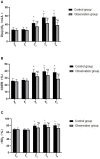Effect of Dexmedetomidine-Assisted Intravenous Inhalation Combined Anesthesia on Cerebral Oxygen Metabolism and Serum Th1/Th2 Level in Elderly Colorectal Cancer Patients
- PMID: 35145993
- PMCID: PMC8821817
- DOI: 10.3389/fsurg.2021.832646
Effect of Dexmedetomidine-Assisted Intravenous Inhalation Combined Anesthesia on Cerebral Oxygen Metabolism and Serum Th1/Th2 Level in Elderly Colorectal Cancer Patients
Abstract
Objective: To observe the effect of dexmedetomidine-assisted intravenous inhalation combined anesthesia on cerebral oxygen metabolism and serum Th1/Th2 levels in elderly patients with colorectal cancer.
Method: From April 2018 to May 2020,100 elderly patients undergoing elective laparoscopic radical resection of colorectal cancer were prospectively selected and randomly divided into observation group and control group. Before induction of anesthesia, the loading dose of dexmedetomidine was given at 0.5 μg/kg, and the infusion time was 15 min. After tracheal intubation, 0.4 μg/kg/h dexmedetomidine was continuously pumped, and the infusion was stopped 40 min before the end of the operation. In the control group, the same amount of 0.9% sodium chloride was injected intravenously in the same way. 30 min before induction of anesthesia (T0), immediately before induction of anesthesia (T1), immediately after tracheal intubation (T2), 40 min before operation (T3), and immediately after operation (T4), record the blood oxygen content of the artery and internal jugular vein Difference (D(a-jv)O2), brain oxygen uptake rate (COER%), brain oxygen saturation (rSO2) mean. VAS scale, Ramsay scale, MoCA scale were taken at 6, 12, 24, and 48 h postoperatively to evaluate analgesia, sedation, and cognitive function. And monitor the levels of interferon-γ (IFN-γ), interleukin-4 (IL-4), myelin basic protein (MBP), neuron-specific enolase (NSE) and S100β. The occurrence of restlessness and adverse reactions during the recovery period of the two groups were compared.
Result: The levels of D(a-jv)O2, COER%, and rSO2 in the control group and observation group were higher than the preoperative basic values at T2, T3, and T4 (P < 0.05); The levels of D(a-jv)O2, COER%, and rSO2 in the observation group were lower than those in the control group at T2, T3, and T4 (P < 0.05). The VAS score and Ramsay score of the observation group were lower than those of the control group at 6, 12, 24, and 48 h after surgery, while the MoCA score was higher than that of the control group (P < 0.05). In addition, the serum IFN-γ, MBP, NSE and S100β levels of the observation group were lower than those of the control group (P < 0.05), and the ratio of IFN-γ/IL-4 was higher than that of the control group (P < 0.05). The overall incidence of adverse reactions in the observation group was lower than that in the control group [32.0% (16/50) vs. 12.0% (6/50), P < 0.05].
Conclusion: Dexmedetomidine-assisted combined intravenous and inhalation anesthesia is beneficial to reduce perioperative cerebral oxygen metabolism and improve postoperative immunosuppression in elderly patients with colorectal cancer. It has a certain protective effect on nerve injury after operation, thus improving the cognitive function of patients and reducing the occurrence of adverse reactions.
Keywords: cerebral oxygen metabolism; cognitive impairment; dexmedetomidine; elderly patients with colorectal cancer; immune function.
Copyright © 2022 Tang, Liu, Huang, Ding, Tan and Zhu.
Conflict of interest statement
The authors declare that the research was conducted in the absence of any commercial or financial relationships that could be construed as a potential conflict of interest.
Figures




Similar articles
-
Application value of dexmedetomidine in anesthesia for elderly patients undergoing radical colon cancer surgery.World J Gastrointest Surg. 2024 Aug 27;16(8):2671-2678. doi: 10.4240/wjgs.v16.i8.2671. World J Gastrointest Surg. 2024. PMID: 39220061 Free PMC article. Clinical Trial.
-
[Effects of dexmedetomidine on recovery period of anesthesia and postoperative cognitive function after robot-assisted laparoscopicradical prostatectomy in the elderly people].Zhong Nan Da Xue Xue Bao Yi Xue Ban. 2015 Feb;40(2):129-35. doi: 10.11817/j.issn.1672-7347.2015.02.003. Zhong Nan Da Xue Xue Bao Yi Xue Ban. 2015. PMID: 25769330 Clinical Trial. Chinese.
-
Influence of dexmedetomidine to cognitive function during recovery period for children with general anesthesia.Eur Rev Med Pharmacol Sci. 2017 Mar;21(5):1106-1111. Eur Rev Med Pharmacol Sci. 2017. PMID: 28338180 Clinical Trial.
-
The clinical effect of dexmedetomidine combined with parecoxib sodium on sedation, antianxiety and prevention of intubation stress in patients undergoing functional endoscopic sinus surgery: a randomised controlled trial.BMC Anesthesiol. 2020 Jul 6;20(1):166. doi: 10.1186/s12871-020-01080-0. BMC Anesthesiol. 2020. PMID: 32631301 Free PMC article. Clinical Trial.
-
Norepinephrine in Goal-Directed Fluid Therapy During General Anesthesia in Elderly Patients Undergoing Spinal Operation: Determining Effective Infusion Rate to Enhance Postoperative Functions.Curr Genomics. 2021 Dec 31;22(8):620-629. doi: 10.2174/1389202922666211213104944. Curr Genomics. 2021. PMID: 35386191 Free PMC article. Review.
Cited by
-
Application value of dexmedetomidine in anesthesia for elderly patients undergoing radical colon cancer surgery.World J Gastrointest Surg. 2024 Aug 27;16(8):2671-2678. doi: 10.4240/wjgs.v16.i8.2671. World J Gastrointest Surg. 2024. PMID: 39220061 Free PMC article. Clinical Trial.
-
Brain protective effect of dexmedetomidine vs propofol for sedation during prolonged mechanical ventilation in non-brain injured patients.World J Psychiatry. 2024 Mar 19;14(3):370-379. doi: 10.5498/wjp.v14.i3.370. eCollection 2024 Mar 19. World J Psychiatry. 2024. PMID: 38617978 Free PMC article.
-
Circulating biomarkers in perioperative management of cancer patients.Precis Clin Med. 2023 Jun 30;6(3):pbad018. doi: 10.1093/pcmedi/pbad018. eCollection 2023 Sep. Precis Clin Med. 2023. PMID: 37954451 Free PMC article. Review.
-
Assessment of cognitive function after surgery for colorectal cancer-a scoping review.BMJ Open. 2024 Dec 3;14(12):e080950. doi: 10.1136/bmjopen-2023-080950. BMJ Open. 2024. PMID: 39627132 Free PMC article.
-
Association between intraoperative dexmedetomidine and all-cause mortality and recurrence after laparoscopic resection of colorectal cancer: Follow-up analysis of a previous randomized controlled trial.Front Oncol. 2023 Mar 30;13:906514. doi: 10.3389/fonc.2023.906514. eCollection 2023. Front Oncol. 2023. PMID: 37064099 Free PMC article.
References
LinkOut - more resources
Full Text Sources
Miscellaneous

